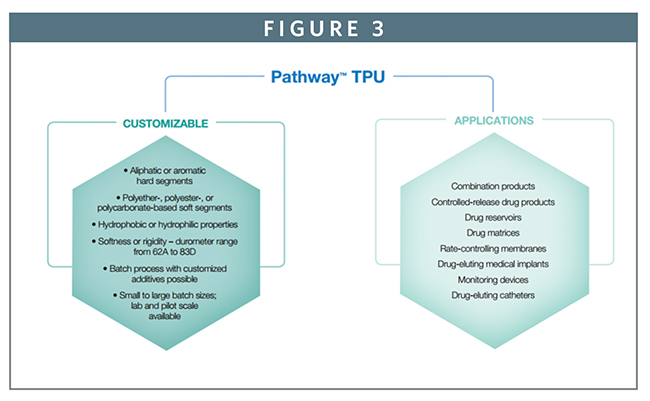Issue:October 2015
ADVANCED DELIVERY DEVICES - Implantable Drug-Eluting Devices: A Novel Approach to Patient Care
INTRODUCTION
Implantable drug-eluting devices (also referred to as implantable drug delivery systems) offer several unique advantages over conventional oral or parenteral drug delivery methods. For instance, they can provide localized, site-specific drug delivery, which is especially important in applications such as cardiology and oncology, where targeted delivery can improve the effectiveness of treatment and minimize side effects or damage to healthy tissue.1-3 The dosage requirements often are lower than alternatives, further reducing the potential for side effects.1 Also, drug-eluting devices can improve patient compliance, one of the greatest challenges in healthcare, as about 50% of conventional medications are not used as prescribed.4 The treatment regimen can be simpler because it requires fewer doctor visits and dosages than traditional therapies.1
Applications of implantable drug-eluting devices include, among others, diabetes management, contraception, HIV/AIDS prevention, chronic pain management, cardiology, oncology, and central nervous system (CNS) health.2,5-10 Along with subcutaneous implantation, various body regions can serve as implantation sites (eg, intravaginal, intravascular, intraocular, intrathecal, and peritoneal).2,6,11-13 In this white paper, developmental and commercial examples of non-biodegradable drug-eluting devices will be presented, along with the versatile properties of thermoplastic polyurethanes, specifically Lubrizol LifeScience’s PathwayTM TPU Excipients for the development of effective drug delivery systems.
BIODEGRADABLE VERSUS NON-BIODEGRADABLE DRUG DELIVERY SYSTEMS
There are two categories of drug-eluting devices: biodegradable and non-biodegradable. Biodegradable drug-eluting devices (also referred to as bioerodible) use biocompatible materials such as polyesteramide (PEA) and Poly Lactic-co-Glycolic Acid (PLGA) to deliver drugs, and once implanted, decompose over time.1,14,15
In contrast to biodegradable, non-biodegradable drug-eluting devices (also referred to as biodurable) use biocompatible materials like silicone rubber (polydimethylsiloxane or PDMS), polyethylene-vinyl acetate (EVA), and thermoplastic polyurethane (TPU) to deliver drugs.16 Non-biodegradable drug-eluting devices can be designed as matrix, reservoir, or osmotic systems to deliver drugs via diffusion or osmosis and are generally less costly than biodegradable devices.1,15 Non-biodegradable drug-eluting devices can be refilled with medication (eg, via injection), and the device’s effects are almost immediately reversible upon removal.1,11,17
Non-biodegradable Pathway TPU excipients are versatile and customizable to a broad range of chemical and physical properties providing variety along a number of dimensions, including drug-release kinetics (short- or long-term), active pharmaceutical ingredient selection (hydrophobic or hydrophilic APIs), processing methods (extrusion, injection molding, or solvent casting), and mechanical performance.16,18-22 These unique attributes provide developers with tremendous design flexibility.
DEVELOPMENTAL & COMMERCIAL EXAMPLES OF NON-BIODEGRADABLE DRUG-ELUTING DEVICES
Non-biodegradable drug-eluting devices are finding increasing applications in the areas of contraception, hormone regulation, diabetes, oncology, pain management, abuse deterrence, and CNS health.5,6,8-10,23,24
Women’s Health
In women’s health, for instance, transmucosal hormone contraceptives delivering progestin and/or estrogen have been developed into combination products made from silicone, EVA, and TPU. A commercial example is Pfizer’s Estring® silicone intravaginal ring (IVR) that releases 2 mg of estradiol for 90 days to treat symptoms associated with menopause.23 Another example is Merck & Co.’s NuvaRing® IVR produced from EVA that delivers 120 micrograms of etonogestrel and 15 micrograms of ethinyl estradiol per day on average for 3 weeks.6 The NuvaRing IVR was prescribed 5.2 million times in 2012 and generated over $720 million in sales revenue in 2014.25,26
Merck also developed Nexplanon® (a new version of Implanon®). The Nexplanon drug-eluting device is made from EVA and delivers 68 mg of etonogestrel for up to 3 years.27 Unlike the NuvaRing, Nexplanon is a rod implanted subcutaneously in the arm.
Subcutaneous contraceptive implants date back to 1966 when the non-profit organization Population Council developed the Norplant.28 Launched in 1983 by Wyeth Pharmaceuticals, the original Norplant was a 5-year non-biodegradable drug-eluting device designed with six silicone capsules each loaded with 36 mg of levonorgestrel. A modern version of the Norplant, Jadelle®, currently is marketed by Bayer Pharmaceuticals.28,29 Several innovative contraceptive and antiviral technologies are under development:
-CONRAD, a non-profit organization, is developing multipurpose prevention technologies with polyurethanes that combine contraceptive and microbicidal attributes into a single IVR device.7 The University of Utah pioneered the development of CONRAD’s IVR with the antiretroviral drug tenofovir and contraceptive levonorgestrol.19,20
-The Oak Crest Institute of Science is developing an antiviral drug-eluting device with PVA-coated silicone to deliver tenofovir alafenamide subcutaneously for HIV/AIDS prevention and treatment.30
-The University of Manitoba is developing a polyurethane IVR for sustained delivery hydroxychloroquine to prevent male-to-female HIV transmission.31
-J3 Bioscience, Inc. (formerly ViroPan) is developing an intravaginal ring with a glycerin formulation to relieve the symptoms of vaginal dryness and aims to provide relief for up to seven days without the use of drugs or hormones.32 The company has completed a pilot human trial and now is preparing for the pivotal study.

Diabetes Treatment
Diabetes, a condition affecting more than 371 million people globally, is another application area where implantable systems offer unique patient solutions. Continuous glucose monitoring (CGM) involves implanting sensors subcutaneously to measure blood sugar. Commercial examples include Dexcom’s G4 PlatinumTM, Medtronic’s Enlite®, and GlySens ICGMTM.33-36
US-based Intarcia Therapeutics is developing a non-biodegradable drug-eluting device to treat type II diabetes.5 Intarcia’s technology, ITCA 650, is a DUROS® implant delivery technology licensed from the ALZA Corporation in 2007.37 ITCA 650 is a small, matchstick-sized osmotic pump consisting of a cylindrical titanium alloy reservoir that is implanted subcutaneously and delivers a steady flow of exenatide, a glucagon-like peptide-1 receptor agonist, for 12 months.5 After successfully completing two of four Phase III trials for ITCA 650, French pharmaceutical company Laboratoires Servier signed a commercialization deal with Intarcia for $1 billion.38 Other implantable diabetes treatment technologies include:
-Delpor’s titanium drug-eluting device that delivers exenatide for treatment of type II diabetes.39,40 Delpor’s system also is designed to deliver drugs for treating bipolar disorder, growth hormone deficiencies, and hepatitis C.39
-NanoPrecision Medical is developing NanoPortalTM, a rice-size titanium implant that delivers exenatide for type II diabetes.41,42
-ViaCyte is developing VC-01TM to treat type I diabetes. VC-01 is a subcutaneous implant composed of ViaCyte’s Encaptra® drug delivery system and human embryonic stem cells (pancreatic PEC-01TM cells).43

Oncology
Drug-eluting devices have been developed for the treatment of, among others, brain tumors, prostate cancer, and bladder cancer.15,44,45 Endo Pharmaceutical’s VantasTM, for example, is a hydrogel depot that delivers 50 mg of histrelin acetate subcutaneously for 12-month relief of prostate cancer symptoms.45 TARIS Biomedical developed a non-biodegradable drug-eluting device to treat non-muscle invasive bladder cancer (NMIBC).44 TARIS Biomedical’s technology is a small flexible pretzel-shaped system that delivers drugs for several weeks through an osmotic pump made of silicone and nickel alloy wire.46 Alternative therapies for NMIBC can cause systemic side effects and are only held in the bladder for a short period of time.44 However, drug-eluting devices implanted in the bladder offer targeted delivery of APIs for a longer period of time in comparison to traditional methods, which may improve symptom relief for patients suffering from NMIBC.
Pain Treatment
Conventional solutions for pain, such as oral and parenteral medications, often are dangerously addictive and extremely expensive. From 1999-2010, the CDC reported a 400% increase in deaths from prescription pain drug overdoses among women and a 265% increase in men.47 In order to address these issues, TARIS Biomedical and Axxia Pharmaceuticals are developing non-biodegradable drug-eluting devices for chronic pain.44.48
Axxia developed a subcutaneous drug-eluting device to deliver hydromorphine continuously for 30 to 90 days with zero-order kinetics to treat chronic pain associated with cancer or HIV/AIDS induced neuropathy.48 TARIS Biomedical’s LiRIS® program delivers lidocaine for a prolonged period of time directly to the bladder of patients suffering from interstitial cystitis/bladder pain syndrome (IC/BPS).49 In 2014, Allergan acquired the LiRIS program for almost $600 million.49 Also, Medtronic’s implantable Synchromed® Infusion Pump System delivered baclofen for muscle spasticity and was made from silicone and titanium.12 The Synchromed system generated an estimated $320 million in sales annually, but was recalled in 2015 due to manufacturing compliance issues and patient safety concerns.50
In order to deter opioid abuse, Titan Pharmaceuticals developed a subcutaneous drug-eluting device called Propuphine®.24,51 Probuphine is an EVA matrix that delivers buprenorphine hydrochloride for 6 months following a single treatment.51 In 2012, Titan entered into an exclusive licensing agreement with Braeburn Pharmaceuticals for commercializing Probuphine.52

CNS Health
Endo Pharmaceuticals’ MedLaunch Implant Program developed a subcutaneous drug-eluting device to deliver risperidone, and similar to Titan’s Probuphine, this technology will be commercialized by Braeburn.10,53 Nearly 50% of patients being treated for schizophrenia are non-compliant.54 Non-biodegradable drug-eluting devices that can deliver antipsychotics at a controlled rate for a prolonged period of time (eg, 60 to 90 days) may provide substantial therapeutic benefit for patients.
Additional therapeutic areas, such as animal health, ophthalmology, and otorhinolaryngology (ear, nose, and throat) offer ample opportunities for non-biodegradable drug-eluting devices and combination product development. Replenish, Inc., for instance, is developing an ophthalmic MicroPumpTM, a small, refillable drug-eluting device for glaucoma and retina disease.55 The SinuSys Corporation is developing the RestoraTM Steroid-Eluting Spacer, a transmucosal polyurethane drug-eluting device for 30-day treatment of sinusitis.56 Zoetis developed the EAZI-BREEDTM CIDR® silicone drug-eluting device to deliver progesterone for livestock reproduction.5

THERMOPLASTIC POLYURETHANES FOR NON-BIODEGRADABLE DRUG-ELUTING DEVICES
Lubrizol LifeSciences partners with pharmaceutical companies from ideation to commercialization. Lubrizol’s non-biodegradable Pathway TPU excipients can be tailored to suit a wide range of drug delivery applications and can be processed into a variety of shapes (eg, rods, tubes, films, and a variety of matrix-type designs) via methods such as hot-melt extrusion, injection molding, and solvent casting. Ethylene oxide, hydrogen peroxide, E-beam radiation, and gamma radiation are acceptable methods of sterilization.
Lubrizol’s 2013 implementation of the International Pharmaceutical Excipients Council’s Good Manufacturing Practice quality system for excipients and database generation of Drug Master Files facilitate non-biodegradable drug-eluting device development. As a result of Lubrizol’s 2014 acquisition of Vesta and 2015 acquisition of Particle Sciences, Lubrizol provides complete drug product development, including pharmaceutical-grade polymer supply and contract research/analytical and contract manufacturing capabilities through to commercialization.
Thermoplastic polyurethanes have exceptional safety records with over 30 years of use in medical devices, such as catheters and pacemakers.58 The unique ability to customize TPU properties allows for the development of advanced drug delivery systems.
REFERENCES
1. Zaki AJ, M, Patil, SK, Baviskar, DT, Jain, DK. Implantable Drug Delivery System: A Review. International Journal of PharmTech Research. 2012;4(1):280–292. Available at: http://sphinxsai.com/2012/pharm/pharm/pt=40(280-292)jm12.pdf. Accessed 2015.
2. Drug-eluting stent. Wikipedia. Wikimedia Foundation. Available at:
https://en.wikipedia.org/wiki/Drug-eluting_stent. Accessed 2015.
3. Brachytherapy. Johns Hopkins Medicine. Available at:
http://www.hopkinsmedicine.org/radiation_oncology/treatments/brachytherapy.html. Accessed 2015.
4. Medication Adherence. CDC. 2013. Available at:
http://www.cdc.gov/primarycare/materials/medication/docs/medication-adherence-01ccd.pdf. Accessed 2015.
5. Intarcia Therapeutics, Inc | Pipeline & Technology. Available at:
http://www.intarcia.com/pipeline-technology/. Accessed 2015.
6. NuvaRing. Wikipedia. Wikimedia Foundation. Available at:
https://en.wikipedia.org/wiki/NuvaRing. Accessed 2015.
7. Multipurpose Prevention Technologies: CONRAD. Available at:
http://www.conrad.org/prevention.html. Accessed 2015.
8. Pogorelc, D. Pain drug-delivery chip may help reduce opiate abuse.
MedCity News. 2012. Available at:
http://medcitynews.com/2012/03/a-button-sized-implant-aims-todeliver-extended-release-pain-meds-for-weeks/. Accessed 2015.
9. Herrlich, S, Spieth, S, Messner, S, Zengerle, R. Osmotic micropumps
for drug delivery. Osmotic micropumps for drug delivery. 2012. Available at:
http://www.sciencedirect.com/science/article/pii/s0169409x12000269. Accessed 2015.
10. Schwarz, A., S. Thoroughman, D. Winstead, S. Decker, and J. Varughese. Development of a Subcutaneous Implant Using Polyurethane as a Semi-Permeable Membrane for the Controlled Release of Risperidone.” Endo Healthcare Solutions.
11. Dalton, Michelle. Drug-delivery Micropump for Chronic Retina Disorders. Ophthalmology Times. 2014. Available at: http://ophthalmologytimes.modernmedicine.com/ophthalmologytimes/news/drug-delivery-micropump-chronic-retina-disorders?page=full. Accessed 2015.
12. SynchroMed II Pump. Medtronic SynchroMed II Drug Pump and ITB
Therapy for Severe Spasticity. Available at:
http://www.medtronic.com/patients/severe-spasticity/therapy/itbtherapy/synchromed-ii-pump/. Accessed 2015.
13. Cima, Michael, Michael Birrer, Marcela DelCarmen, Laura Tanenbaum, and Hongye Ye. Implantable Drug Delivery Device for Ovarian Cancer. MIT Deshpande Center for Technological Innovation. 2011. Available at:
https://deshpande.mit.edu/portfolio/project/implantable-drugdelivery-device-ovarian-cancer. Accessed 2015.
14. Drug Delivery. Products & Technologies. DSM Biomedical. Available
at: http://www.dsm.com/markets/medical/en_US/productspage/products-resorbable-materials.html. Accessed 2015.
15. Shuwisitkul, Duangratana. Biodegradable Implant With Different Drug Release Profiles. Freie Universitat, 2011. Available at:
http://www.diss.fuberlin.de/diss/servlets/MCRFileNodeServlet/FUDISS_derivate_000000009580/Duangrat_thesis_online.pdf. Accessed 2015.
16. Marchant, Nancy. Drug Release and Non Degradable Polymers: Thermoplastic Polyurethanes offer greater control.
17. Mccall AA, Swan EE, Borenstein JT, Sewell WF, Kujawa SG, Mckenna MJ. Drug delivery for treatment of inner ear disease: current state of knowledge. Ear Hear. 2010;31(2):156-65.
18. Clark, Johnson et al. 2012. A hot-melt extruded intravaginal ring for the sustained delivery of the antiretroviral microbicide UC781. J Pharm Sci 101(2): 576-587.
19. Clark, Justin T., Meredith R. Clark, Namdev B. Shelke, Todd J. Johnson, Eric M. Smith, Andrew K. Andreasen, Joel S. Nebeker, Judit Fabian, David R. Friend, and Patrick F. Kiser. Engineering a Segmented Dual-Reservoir Polyurethane Intravaginal Ring for Simultaneous Prevention of HIV Transmission and Unwanted Pregnancy. PLoS ONE. Burnet Institute, Australia, 2014.
20. Clark, Meredith R., Justin T. Clark, Todd J. Johnson, Namdev B. Shelke, Joel S. Nebeker, Gustavo F. Doncel, David R. Friend, and Patrick F. Kiser. Development and Pharmacokinetics of a 90-Day Intravaginal Ring for the Sustained Co-Delivery of the Microbicide Tenofovir and Contraceptive Levonorgestrel. USAID.
21. J.Y Cherng, T.Y. Houa, M.F.Shihb, H. Talsma, and W.E. Hennink. Polyurethane-based drug delivery systems. Int J Pharm 2013.
22. Khandwekar, A.P., Patil, D. P. Hardikar, A. A. Shouche, Y.S. and Doble, M. In vivo modulation of foreign body response on polyurethane by surface entraptment technique. J. Biomed Mater. Res. 2010.
23. Colas, Andre. Silicones in Pharmaceutical Applications. Dow Corning Healthcare Industries.
24. Saxena, Varun. UPDATED: Titan Pharma Trial of Implant for Addicts on Track. FierceDrugDelivery. 2014. Available at:
http://www.fiercedrugdelivery.com/story/titan-pharma-trial-implantaddicts-track/2014-09. Accessed 2015.
25. Gallagher, Mary Pat. One Year After $100M NuvaRing Deal, NJ Cases Fall to Zero. New Jersey Law Journal, 2015. Available at:
http://www.njlawjournal.com/id=1202719603346/One-Year-After-100M-NuvaRing-Deal-NJ-Cases-Fall-to-Zero?slreturn=20150610111609. Accessed 2015.
26. Sifferlin, Alexandra. Women Who Stand By Their NuvaRing. Time Magazine, 2014. Available at: http://time.com/6764/women-whostand-by-their-nuvaring/. Accessed 2015.
27. Nexplanon® (etonogestrel Implant) 68 Mg. Merck Sharp & Dohme BV. Available at:
https://www.merck.com/product/usa/pi_circulars/n/nexplanon/nexplanon_pi.pdf. Accessed 2015.
28. Norplant. Wikipedia. Wikimedia Foundation. Available at:
https://en.wikipedia.org/wiki/Norplant. Accessed 2015.
29. Jadelle. Bayer: Science for A Better Life. Bayer AG. Available at:
http://www.jadelle.com/. Accessed 2015.
30. Carstensen, Melinda. Scientists design implantable device for long-acting
HIV prevention. Fox News, 2015. Available at:
http://www.foxnews.com/health/2015/05/05/scientists-designimplantable-device-for-long-acting-hiv-prevention/. Accessed 2015.
31. Chen Y, Traore YL, Li A, Fowke KR, Ho EA. Development of polyether urethane intravaginal rings for the sustained delivery of hydroxychloroquine. Drug Des Devel Ther. 2014;8:1801-15.
32. Pathway Excipients. Lubrizol LifeSciences. Available at:
https://www.lubrizol.com/Life-Science/Documents/Implantable-Drug-Delivery-Systems/Pathway-Excipients.pdf. Accessed 2015.
33. General Diabetes Facts – JDRF: Improving Lives. Curing Type 1
Diabetes. JDRF Improving Lives Curing Type 1 Diabetes. Available at:
http://jdrf.org/about-jdrf/fact-sheets/general-diabetes-facts/. Accessed 2015.
34. Introducing the Dexcom G4® PLATINUM System with ShareTM. Dexcom G4 Platinum Continuous Glucose Monitor. Available at:
http://www.dexcom.com/dexcom-g4-platinum-share. Accessed 2015.
35. 3 Ways to Get Started. Enlite™ Sensor. Available at:
https://www.medtronicdiabetes.com/treatment-and-products/enlitesensor. Accessed 2015.
36. GlySens ICGM System. GlySens Next Generation Continuous
Glucose Monitoring for Better Diabetes Health. Available at:
http://glysens.com/products/glysens-icgm/. Accessed 2015.
37. Intarcia Therapeutics, Inc. Announces Completion of Enrollment of ITCA 650 Phase 1b Study for the Treatment of Type 2 Diabetes. 2009. Available at: http://www.intarcia.com/media/pressreleases/2009-apr-24-completes-enrollment.html. Accessed 2015.
38. Intarcia and Servier Sign Ex-U.S. Partnership for ITCA 650 in Diabetes; Intarcia Retains Independence & Full Control of the U.S. & Japan. 2014. Available at: http://www.intarcia.com/media/pressreleases/2014-nov-12-ex-us-partnership.html. Accessed 2015.
39. DELPOR’S DEVICE. Delpor. Available at:
http://www.delpor.com/?page_id=356. Accessed 2015.
40. TYPE 2 DIABETES. Delpor. Available at:
http://www.delpor.com/?page_id=900. Accessed 2015.
41. NanoPortal Technology: A New Approach to Drug Delivery. Nano Precision Medical. Available at:
http://www.nanoprecisionmedical.com/technology/nanoportaltechnology. Accessed 2015.
42. Type II Diabetes. Nano Precision Medical. Available at:
http://www.nanoprecisionmedical.com/pipeline/diabetes. Accessed 2015.
43. VC-01 Diabetes Therapy. Viacyte Inc. Available at:
http://viacyte.com/products/vc-01-diabetes-therapy/. Accessed 2015.
44. Our Technology. TARIS Biomedical. Available at:
http://www.tarisbiomedical.com/our_tech.php. Accessed 2015.
45. Vantas (histrelin Implant). FDA.gov. Endo Pharmaceuticals, 1 Nov. 2010. Available at: http://www.accessdata.fda.gov/drugsatfda_docs/label/2011/021 732s013lbl.pdf. Accessed 2015.
46. $10,000 ISSAC Award for Innovation Presented to MIT PhD. PR
Newswire. 2009. Available at: http://www.prnewswire.com/newsreleases/10000-issac-award-for-innovation-presented-to-mit-phd-62237832.html. Accessed 2015.
47. Prescription Painkiller Overdoses. Centers for Disease Control and Prevention. July 2013. Available at: http://www.cdc.gov/vitalsigns/prescriptionpainkilleroverdoses/.
Accessed 2015.
48. Axxia Pharmaceuticals. Axxia Pharmaceuticals. Available at: http://www.axxiapharma.com/. Accessed 2015.
49. Allergan Acquires LiRIS Program from TARIS Biomedica. TARIS Biomedical. 2014. Available at:
http://www.tarisbiomedical.com/documents/Taris_Allergan_PR_FINAL_8_13_14_.pdf. Accessed 2015.
50. Cairns, Elizabeth. Medtronic Ordered To Stop Making SynchroMed II
Pumps. Seeking Alpha. 2015. Available at:
http://seekingalpha.com/article/3118206-medtronic-ordered-to-stopmaking-synchromed-ii-pumps. Accessed 2015.
51. Products & Technologies. Titan Pharmaceuticals. Available at:
http://www.titanpharm.com/products.htm. Accessed 2015.
52. TITAN PHARMACEUTICALS LICENSES EXCLUSIVE PROBUPHINE®
COMMERCIALIZATION RIGHTS IN U.S. AND CANADA TO
BRAEBURN PHARMACEUTICALS. Titan Pharmaceuticals, Inc. 2012.
Available at: http://www.titanpharm.com/press/2012/121217-press-rel-titan-partnering-update.htm. Accessed 2015.
53. Braeburn Pharmaceuticals expands pipeline to include two schizophrenia treatments. PR Newswire. 2015. Available at:
http://www.prnewswire.com/news-releases/braeburnpharmaceuticals-expands-pipeline-to-include-two-schizophreniatreatments-300075766.html. Accessed 2015.
54. Schizophrenia Facts and Statistics. Schizophrenia.com. Available at:
http://www.schizophrenia.com/szfacts.htm#. Accessed 2015.
55. Product Description. Replenish Inc. Available at: http://replenishinc.com/our-technology/product-description. Accessed 2015.
56. The Restora Steroid-Eluting Spacer. Naturally Powered Sinus Solutions RSS. Available at: http://sinusys.com/restora/. Accessed 2015.
57. Eazi-Breed CIDR® Cattle Insert (progesterone). Zoetis United States. Available at: https://www.zoetisus.com/products/beef/eazi-breedcidr.aspx. Accessed 2015.
58. Polyurethanes and Medical Applications. American Chemistry Council. Available at:
http://polyurethane.americanchemistry.com/Introduction-to-Polyurethanes/Applications/Polyurethanes-and-Medical-Applications. Accessed 2015.
To view this issue and all back issues online, please visit www.drug-dev.com.

Samuel D. Trohman is currently a Marketing Specialist for Lubrizol LifeSciences. Mr. Trohman earned his BA in Biology from the University of Colorado in 2010 and his MBA from Indiana University’s Kelley School of Business in 2014. He was also a coauthor for Cardiac arrest: unveiling the differences within. Crit Care Med (2011).

Joey L. Glassco is a Global Market Manager for Lubrizol LifeSciences. Her main focus is new business development in the area of drug-eluting devices. Her efforts support the company’s position as a supplier of pharmaceutical and medical polymers to include formulation and manufacturing.
Dr. Elena Draganoiu is a Technology Manager with LifeScience Polymers business at Lubrizol. She is a graduate of the University of Cincinnati (PhD, Pharmaceutics). She has 10 years of experience working in the excipients industry and has also worked as a resident pharmacist and in academia. Dr. Draganoiu is responsible for leading Lubrizol’s technical programs in the area of pharmaceutical ingredients.

Carey Boyum is a Technical Marketing Manager for Lubrizol LifeSciences and has held various sales and marketing positions since 2004. Currently, he is actively promoting products from Lubrizol’s acrylic acid and thermoplastic polyurethane technology platforms, primarily to the pharmaceutical market. He earned his BA in Chemistry from Augustana College.
Total Page Views: 11070









